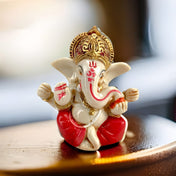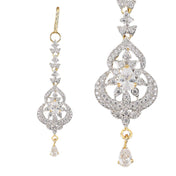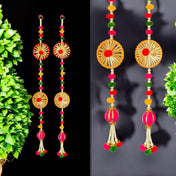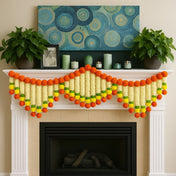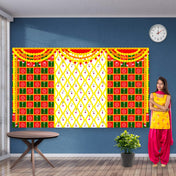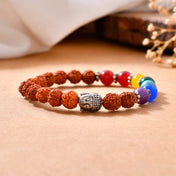A pooja backdrop is more than just a decoration in Indian spiritual ceremonies. It serves as the sacred space where prayers are offered, rituals are performed, and connections with the divine are established. Deeply rooted in Indian culture, the pooja backdrop represents respect and devotion, enhancing the holiness of the area where deities are worshipped.
The importance of a well-designed pooja backdrop lies in its ability to turn an ordinary place into a spiritual atmosphere that reflects tradition and calmness. Whether for daily prayers, grand festivals, or special events, the backdrop sets the mood, inviting positive energy and concentration during worship.
This article shares practical pooja backdrop setup tips aimed at helping you create such a divine atmosphere in your home or community space. From selecting materials to incorporating meaningful decorations, we explore ways to enhance your pooja ceremonies through effective backdrop decoration. Embrace these ideas to honor cultural heritage while crafting a visually stunning and spiritually uplifting environment.
For those looking for inspiration or resources, consider exploring LoveNspire's Pooja Backdrop Decoration Collection, which offers traditional Indian backdrop decorations for various occasions. Additionally, if you're interested in DIY projects, you might find our DIY tips and ideas for creating a decorative pooja backdrop helpful. Finally, don't forget about the beauty of Backdrop Indian Garlands, which can add an extra layer of elegance to your pooja setup.
1. Understanding the Role of a Pooja Backdrop
A pooja backdrop is more than just a decoration; it is an important part of our cultural tradition that promotes spiritual harmony during worship. By creating the right atmosphere, it turns the pooja area into a sacred space where devotees can feel a connection with the divine.
The backdrop serves to highlight the main focus of the ceremony—the pooja centerpiece, which usually consists of idols or images of deities. Its purpose is to draw attention and respect towards this central point of worship.
The Significance of Backdrop Design
The design of the backdrop is crucial in enhancing the overall experience. It should evoke feelings of spirituality and cultural richness through its choice of colors, patterns, and symbols. Each element used in the backdrop carries its own significance:
- Marigold garlands symbolize auspiciousness and protection.
- Peacock feathers represent purity and divine beauty.
- Om symbols and sacred geometric patterns invoke positive energy and focus.
Different festivals bring different themes for pooja backdrops. For example, during Navratri, vibrant reds and yellows are used to honor Goddess Durga's power; Diwali backdrops often feature golds and oranges to reflect light and celebration.
Enhancing the Spiritual Ambiance
The careful arrangement of these elements within the backdrop not only adds beauty but also enriches the spiritual atmosphere. This transforms every pooja into a visually captivating ritual that touches the heart.
To achieve such stunning results, one can explore various backdrop hanging options that are versatile decorations suitable for any occasion or event. Additionally, understanding how to create a stunning pooja backdrop can further enhance the pooja experience by making it visually appealing while preserving its spiritual essence.
2. Choosing the Right Materials for Your Pooja Backdrop
Selecting the perfect fabric is essential to achieving a divine ambiance that honors tradition while reflecting your personal style. The choice of traditional textiles plays a crucial role in enhancing your pooja backdrop.
1. Rich Fabrics for Grand Celebrations
Rich fabrics like silk, brocade, and velvet are excellent for major festivals such as Diwali or Navratri. Their luxurious texture and vibrant sheen create an opulent look that enhances the sacred atmosphere. These materials carry cultural significance, often associated with prosperity and auspiciousness.
2. Budget-Friendly Alternatives
For those seeking budget-friendly materials, repurposed saris or dupattas featuring traditional prints provide an economical yet charming alternative. Using these fabrics not only reduces waste but also brings authentic ethnic patterns and colors into your setup, making it unique and meaningful without compromising beauty.
3. Lighter Fabrics for Minimalist Setups
Lighter fabrics such as chiffon or organza suit smaller or minimalist setups. Their sheer quality allows soft layering, adding subtle elegance without overwhelming the space. These options work well for intimate pooja ceremonies or when you prefer a delicate, airy backdrop.
Choosing fabrics carefully balances aesthetics, budget, and functionality—each element contributing to a harmonious pooja environment tailored to your celebration’s scale and spirit.
3. Structural Elements and Setup Essentials
Creating a pooja backdrop that remains stable and secure throughout your ceremony is essential. A well-built structure supports not only the visual appeal but also the safety of delicate decorations and idols.
1. Invest in Sturdy Frames
Sturdy frames made from metal or wood offer reliable strength, capable of bearing the combined weight of fabrics, floral garlands, lights, and other adornments. These frames provide a solid foundation, especially for elaborate setups during major festivals or weddings.
2. Embrace Sustainability with Bamboo Structures
An appealing alternative embraces sustainability with bamboo structures. Bamboo is lightweight yet robust, making it an eco-friendly choice that still ensures durability. Its natural texture adds an earthy charm aligning beautifully with traditional pooja aesthetics.
3. Opt for Flexibility with Temporary Fixtures
For those seeking flexibility or frequent rearrangements, temporary fixtures such as curtain rods and adhesive hooks come into play. These options facilitate easy installation and removal without damaging walls or surfaces. Ideal for small spaces or rental homes, they help create a divine ambiance swiftly without permanent alterations.
Choosing the right structural support in your pooja backdrop setup influences both functionality and elegance. Balance sturdiness with ease of assembly to complement your vision while honoring sacred traditions.
4. Enhancing Visual Appeal with Decorations
Creating a pooja backdrop that captivates the spirit begins with natural elements that breathe life into the sacred space. Fresh flowers like marigold and jasmine are timeless choices, celebrated not only for their vibrant hues but also for their divine fragrance. These floral garlands drape elegantly across the backdrop, infusing the environment with purity and serenity. Their natural aroma elevates the spiritual experience, inviting calm and focus during worship.
Crafted accents add a personal touch that reflects devotion and creativity. Handmade decorations such as tissue paper flowers bring softness and color in customizable ways, perfect for matching specific festival themes or personal preferences. Hand-painted symbols—like om, lotus motifs, or sacred geometric patterns—can be delicately integrated into the backdrop to honor tradition while showcasing artistry.
Consider these decoration ideas to enrich your pooja setup:
- Floral garlands: Combine fresh blooms with artificial ones to maintain freshness throughout longer ceremonies.
- Handcrafted paper flowers: Lightweight and reusable, ideal for creating layered textures.
- Painted cloth panels or wooden plaques: Feature meaningful symbols painted by local artisans or DIY enthusiasts.
Incorporating both natural freshness and handcrafted charm results in a visually stunning and spiritually uplifting backdrop that resonates deeply with Indian cultural values.
5. Creating a Calm Atmosphere with Lighting and Layout Planning
Ambient lighting techniques can turn your pooja backdrop into a peaceful and spiritual space. By using warm string lights or soft-glowing lanterns, you can create an inviting atmosphere that enhances the sacredness of the ceremony. These subtle lights will also highlight intricate decorations and promote a meditative mood, making the worship experience even more special.
Lighting Ideas to Enhance Your Setup
Here are some lighting ideas you can consider to elevate your pooja setup:
- Use warm white or golden-hued LED string lights to create a soft glow without overwhelming the space.
- Place small lanterns or diyas at different heights to add depth and warmth to the overall look.
- Incorporate candles safely into your decoration to bring in flickering light that represents purity and devotion.
Importance of Layout Optimization
The way you arrange your idols or deities is crucial in directing attention towards them while maintaining harmony within the backdrop. It's important to avoid overcrowding by balancing decorative elements with open spaces so that each item has its own place and can be appreciated fully.
Key Tips for Effective Layout Planning
Here are some key tips for planning an effective layout:
- Position central deities prominently, ensuring they are clearly visible and well-lit.
- Group related decorations together (such as flowers or handcrafted items) to form cohesive clusters without creating clutter.
- Leave clear pathways around the setup so that it is easy for people to move around during rituals.
- Whenever possible, try to align backdrop elements symmetrically to create visual balance and serenity.
By carefully arranging your decorations and using gentle ambient lighting, you can invite a deeper connection during pooja ceremonies and transform your space into a divine retreat.
6. Thematic Backdrop Ideas for Specific Occasions (Navratri, Diwali, Weddings)
Creating a pooja backdrop that captures the essence of an occasion enhances the entire ceremony.
Navratri Decoration Ideas
Navratri decoration ideas often revolve around vibrant hues such as deep reds, bright oranges, and sunny yellows—colors that symbolize energy and devotion. Incorporate motifs like lotus flowers, peacocks, or images of Goddess Durga to create a backdrop pulsating with cultural significance.
Diwali Pooja Backdrop Themes
For Diwali pooja backdrop themes, embrace shimmering golds and rich purples or royal blues to echo the festival of lights and prosperity. Use decorative elements like diyas, rangoli patterns, and intricate paisley prints to enhance visual richness. String lights with warm glows can frame these themes beautifully, adding a divine sparkle.
Wedding Pooja Backdrops
Wedding pooja backdrops call for elegance and tradition fused with celebration. Shades of maroon, ivory, and gold set a regal tone. Embellish with fresh floral garlands, traditional torans, or mirror work textiles that bring auspicious charm to the altar. Symbolic motifs such as mangalsutra designs or kalash symbols help connect deeper cultural roots.
These Pooja Backdrop Setup Tips encourage personal expression while honoring each occasion’s unique vibe, allowing worshippers to connect meaningfully through carefully curated aesthetics.
7. Incorporating Traditional Craftsmanship in Modern Setups
Handmade ethnic products carry the soul of traditional craftsmanship, offering pooja backdrops a distinctive charm and authenticity that mass-produced decor often lacks. Brands like LoveNspire celebrate these artisanal treasures by transforming age-old techniques into contemporary designs, perfectly suited for today’s spiritual spaces.
Key benefits of incorporating handmade ethnic products include:
- Authenticity: Each piece tells a story, crafted with care and cultural knowledge passed through generations.
- Uniqueness: No two items are exactly alike, lending your pooja backdrop a personalized, one-of-a-kind appeal.
- Quality: Handcrafted materials often boast superior durability and intricate detailing compared to machine-made alternatives.
- Cultural Connection: Using such decor deepens the spiritual ambiance by honoring Indian heritage and artistic traditions.
LoveNspire’s collection spans from intricately embroidered textiles to hand-painted motifs and handwoven accents. These elements blend seamlessly with modern décor trends, enriching the pooja setup without overwhelming it. Imagine a backdrop adorned with delicately embroidered silk panels paired with subtle metallic threadwork or handcrafted wooden carvings painted in vibrant hues—each component elevates the sacred space while paying homage to timeless artistry.
Incorporating these handmade ethnic products encourages conscious appreciation of craftsmanship, turning your pooja area into not just a place of worship but a curated gallery of cultural expression. For instance, LoveNspire's backdrop cutouts are a popular choice in event decor, especially for celebrations such as Diwali and Eid, adding a unique touch to any pooja setup.
8. Sustainability Tips in Pooja Backdrop Decoration (Eco-Friendly Practices)
Sustainability in pooja backdrop decoration honors not only the environment but also the spirit of mindfulness integral to Indian rituals. Conscious choices in materials and reuse help reduce waste while maintaining the sanctity of your setup.
Reusing artificial flowers stands out as a practical and beautiful approach. These flowers, often crafted with vibrant colors and intricate details, can be carefully stored and repurposed for multiple events. Doing so minimizes the demand for fresh floral arrangements, conserving natural resources and cutting down on costs. Consider:
- Gently cleaning artificial garlands and floral strings after use to keep them vibrant.
- Combining reused elements with fresh flowers for a dynamic and rich texture.
- Storing decorations in breathable fabric bags to prevent dust buildup.
Selecting eco-friendly fabrics such as organic cotton, jute, or handwoven khadi for backdrop draping adds a sustainable touch without compromising elegance. These materials biodegrade naturally, reducing environmental impact post-celebration.
Biodegradable decor items like dried flower garlands, banana leaves, and terracotta accents introduce authenticity while aligning with green practices. Craft materials made from recycled paper or natural fibers invite creativity and respect for nature into your design process.
Embracing sustainability in pooja backdrops reflects a deeper connection to tradition—where reverence extends beyond ritual objects to include care for the Earth itself. This ethos encourages thoughtful decorating that can be cherished across festivities without strain on the planet’s resources.
Conclusion
Creating a pooja backdrop is a beautiful way to celebrate your culture while making your rituals more meaningful. By following these tips, you can create a space that is personal and spiritually uplifting.
- Use colors, fabrics, and handcrafted details that represent your family's traditions.
- Include symbolic elements that honor cultural values and show respect for the occasion.
- Make your backdrop more than just decoration—let it be a visual prayer that brings peace and divinity into your home.
By being creative within the boundaries of tradition, you can turn each ceremony into a heartfelt experience that strengthens your connection to your heritage and spirituality. Your pooja space will not only reflect your devotion but also showcase the rich tapestry of Indian culture intertwined with your own unique story.










